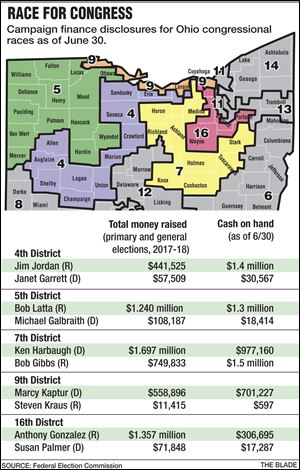
Congressional newcomers face uphill financial battle against incumbents
7/20/2018
Incumbent U.S. Rep. Marcy Kaptur, left, (D., Toledo) faces Republican Steven Kraus in the General Election while Incumbent U.S. Rep. Bob Latta, right, (R., Bowling Green) will face Democrat James L. Neu, Jr., of Perrysburg.
THE BLADE
Buy This Image
Editor’s note: This article has been updated with correct numbers for Janet Garrett’s fund-raising.
Since the start of 2017, Toledo’s Democratic U.S. Rep. Marcy Kaptur has raised nearly $600,000 in her bid to keep her House seat of 35 years.
The amount, like the $700,000 stashed in her campaign war chest, is a far cry from the fund-raising figures of her opponent, Republican Steven Kraus. Kraus has raised just more than $11,000 — $4,000 of which he personally loaned to his campaign — and closed last month with $597 on hand.
The 9th District snaking along Lake Erie from Toledo to Cleveland is just one place in Ohio where incumbent congressmen are far out-raising their challengers.
In 14 congressional districts where incumbents are running, 12 of those candidates hold a fund-raising advantage, according to Federal Election Commission data.
The trend represents one of the edges incumbents have over their opponents, and a hurdle newcomers and even legislators in other offices face trying to unseat long-established lawmakers, said Richard Hall, a professor of political science and public policy at the University of Michigan. He added that in 2016, 97 percent of House members who sought a repeat term were successful.
“To challenge an incumbent [in Congress] you need over a million dollars. You need to have some substantial sum,” Mr. Hall said.

In the 9th District, Kraus, a former state representative who uses the slogan “Steve Kraus for the Haus,” said he’s planning a fund-raising cruise this summer to boost his coffers.
“Everybody running for office always wants more money,” Kraus said. “All Marcy’s money doesn’t ensure victory. I will have enough money to defeat her in November, which is the goal. It’s not about the money. It’s about the votes, and money doesn’t always equate to votes.”
Kraus, of Sandusky, represented the 89th District in the Ohio General Assembly until 2015 when he was convicted of felony theft, a charge he has disputed. A felony conviction bars someone from serving in the state House, but not Congress.
He previously ran for the 9th Congressional District seat in 2012 and 2016 but lost in Republican primaries.
While most of Kraus’ contributions have come from individuals, Miss Kaptur has individuals and PACs contributing to her campaign, including $5,000 from United Steelworkers, Boilermakers Local 85, and American Crystal Sugar Company. PACs that support multiple candidates are able to contribute $5,000 per election to those candidates; individuals can contribute $2,700.
Miss Kaptur’s campaign did not respond to a request for comment.
Although they’re generally among a campaign’s most generous donors, PACs are less concerned about helping candidates win a race and more concerned about ensuring access to those candidates, Mr. Hall said.
“Most of the money, especially PAC money, goes to incumbents not because the donor believes it’s going to affect the election, but because they need access to the legislator after the election,” he said.
Once candidates amass enough money over several election cycles, they will often be in a position to contribute to other candidates and congressional candidate committees in D.C.
“If you’ve got incumbents who have large campaign war chests and they’re going to win anyway, then they can put that money to better use in helping their colleagues,” Mr. Hall said.
U.S. Rep. Jim Jordan, a powerful Republican congressman whose district stretches from Sandusky County to the northern Columbus suburbs, has donated to Republican candidates in Idaho, Virginia, Pennsylvania, and South Carolina. He has received contributions from PACs representing Rite Aid, Kraft Heinz, Universal Music Group, and Google.
Mr. Jordan has raised more than $440,000 since 2017 and ended the month with more than $1.4 million on hand. He made headlines earlier this month after denying he knew about alleged sexual misconduct while he was a wrestling coach at Ohio State University.
By comparison, his Democratic opponent Janet Garrett was at a fund-raising disadvantage, having raised $144,000 and ending the filing period with $97,000 in the bank.
In Lucas County’s other congressional district, incumbent Republican Bob Latta has raised $1.2 million and ended the month with about the same in cash reserves. His filings show the 5th District congressman received contributions from PACs representing Aetna, Walmart, and the American Soybean Association. Mr. Latta did not return a request for comment.
Mr. Latta’s opponent, Democrat Michael Galbraith, received more than $100,000 in contributions but had only $18,000 left by the end of the filing period.
“Is money a concern? Sure,” Mr. Galbraith said. “It’s always a concern. But we will continue our fund-raising efforts. I think we’re in an extremely good position.”
In Ohio’s 7th District, Democrat Ken Harbaugh is fighting to join that elusive 3 percent who are able to unseat incumbents. Experts said the Yale-educated former U.S. Navy pilot is mounting a formidable challenge.
Mr. Harbaugh has raised nearly $1.7 million in his race against Republican U.S. Rep. Bob Gibbs in what is considered a Republican-leaning district extending from just south of Lake Erie to Coshocton County. Money tends to flow into competitive races where one party believes it could flip a district.
Contact Liz Skalka at lskalka@theblade.com, 419-724-6199, or on Twitter @lizskalka.